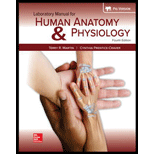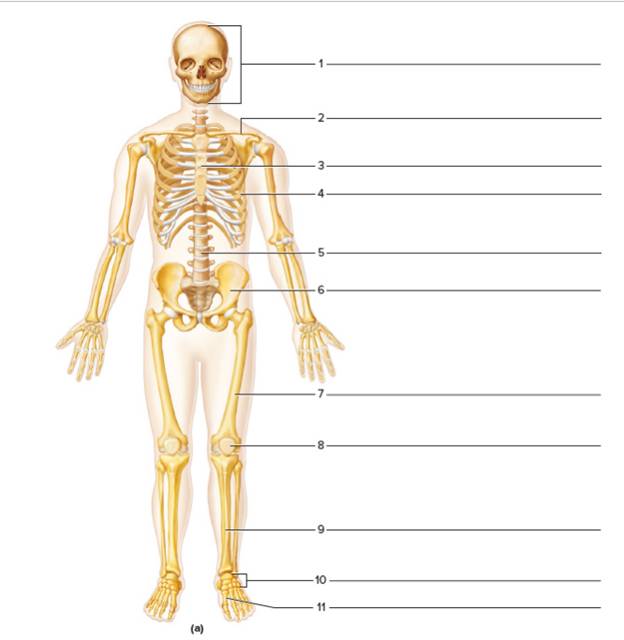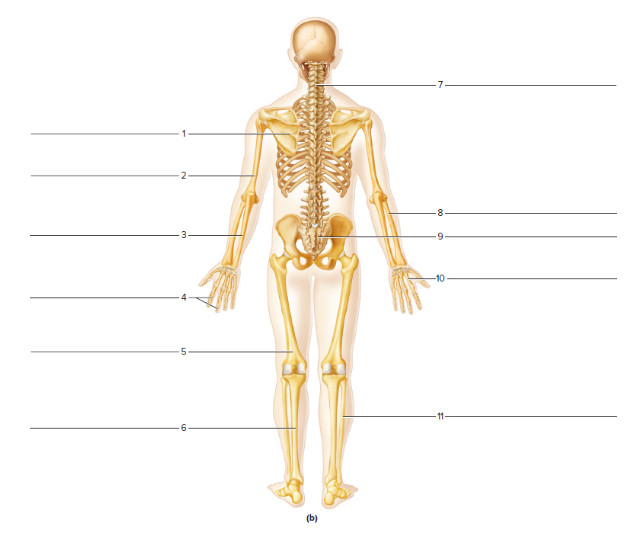
Laboratory Manual For Human Anatomy & Physiology
4th Edition
ISBN: 9781260159363
Author: Martin, Terry R., Prentice-craver, Cynthia
Publisher: McGraw-Hill Publishing Co.
expand_more
expand_more
format_list_bulleted
Textbook Question
Chapter 13, Problem F13.3A
FIGURE 13.3 Label the major bones of the skeleton: (a) anterior view; (b) posterior view. 

Expert Solution & Answer
Want to see the full answer?
Check out a sample textbook solution
Students have asked these similar questions
What are functions of cuboidal cells in the kidney? Select all that apply.
Concentration of gases
Dilution of chemicals
Secretion of molecules
Nutrition to tissues
Support of tissues
Absorption of molecules
question1 In plants, epithelial tissue is only found as the outermost cell layer and acts as a barrier. In humans, epithelial tissue is found inside the body as well as on the surface.
What function(s) does/do epithelial tissue carry out in humans? Select all that apply.
Waste storage
Filtration
Oxygen transport
Protection
Diffusion
Osmosis
Absorption
What words best describes this organism?
a. Unicellular/nonmotile
Ob. unicellular/motile
c. colonial/nonmotile
d. colonial/motile
e. multicelluar
O f. siphonous
g. none of these
Chapter 13 Solutions
Laboratory Manual For Human Anatomy & Physiology
Ch. 13 - The vertebral column does not include a rib....Ch. 13 - The ____________ bone is part of the pectoral...Ch. 13 - A _____________ is a very large projection on a...Ch. 13 - A ____________ is a shallow depression on a bone....Ch. 13 - Bones that might form in the skull, but are not...Ch. 13 - The _____________ is a bone in the upper limb....Ch. 13 - A bone in the lower limb is the __________. hip...Ch. 13 - A ____________ is a depression type of bone...Ch. 13 - The bones of the skull, face, neck, and trunk make...Ch. 13 - Locate and name the largest foramen in the skull.
Ch. 13 - Locate and name the largest foramen in the...Ch. 13 - FIGURE 13.3 Label the major bones of the skeleton:...Ch. 13 - FIGURE 13.4 Identify the bones in this random...Ch. 13 - List any of the bones shown in figure 13.4 that...Ch. 13 - Match the terms in column A with the definitions...Ch. 13 - Match the terms in column A with the definitions...Ch. 13 - The extra bones that sometimes develop between the...Ch. 13 - Small bones occurring in some tendons in the hand...Ch. 13 - The cranium and facial bones compose the...Ch. 13 - The _______________ bone supports the tongue.Ch. 13 - The ___________ at the inferior end of the sacrum...Ch. 13 - Most ribs are attached anteriorly to the...Ch. 13 - The thoracic cage is composed of ___________ pairs...Ch. 13 - The scapulae and clavicles together form the...Ch. 13 - Which of the following bones is not part of the...Ch. 13 - Each wrist is composed of eight bones called...Ch. 13 - The hip bones (coxal bones) are attached...Ch. 13 - The _____________ bone covers the anterior surface...Ch. 13 - The bones that articulate with the distal ends of...Ch. 13 - All finger and toe bones are called ____________.
Additional Science Textbook Solutions
Find more solutions based on key concepts
True or false? Some trails are considered vestigial because they existed long ago.
Biological Science (6th Edition)
Q2. Which statement best defines chemistry?
a. The science that studies solvents, drugs, and insecticides
b. Th...
Introductory Chemistry (6th Edition)
Why do scientists think that all forms of life on earth have a common origin?
Genetics: From Genes to Genomes
4.1 Write the symbols for the following elements.
a. copper
b. platinum
c. calcium
d. manganese
e. Iron
...
Chemistry: An Introduction to General, Organic, and Biological Chemistry (13th Edition)
Gregor Mendel never saw a gene, yet he concluded that some inherited factors were responsible for the patterns ...
Campbell Essential Biology (7th Edition)
Knowledge Booster
Learn more about
Need a deep-dive on the concept behind this application? Look no further. Learn more about this topic, biology and related others by exploring similar questions and additional content below.Similar questions
- Identify the phylum or class. a. Euglenophyta b. Dinoflagellata c. Bacillariophyceae d. Oomycetes e. Phaeophyceae O f. Myxomycota g. Xanthophyceae ○ h. Chrysophyceae i. Dictyosteliomycota O j. Rhodophyta Ok. Chlorophyceaens I. Charophyceaensarrow_forwardWhat is produced inside the indicated structure (Fucus). a. eggs O b. antheridia ○ c. sperm d. zygotes e. none of thesearrow_forwardGreen Algae, as a group, is actually paraphyletic with one subgroup more closely related to higher plants than the other. Which of the following green algae groups is more closely related to higher plants: a. Charophyceans b. Chlorophyceans c. Rhodophyta d. Xanthophyceansarrow_forward
- A single-celled green algal genus that is motile with 2 flagella, has a cup shaped chloroplast, and an eyespot: a. Volvox b. Chlamydomonas c. Euglena d. Codiumarrow_forwardA[n] ___ is produced by members of the Myxomycota when there is a lack of moisture. a. plasmodiocarp b. aethalium c. sclerotium d. plasmodiumarrow_forwardWhich of the following is not true about the life-cycle of Fucus. a. 8 eggs per oogonium b. 64 sperm per antheridium c. eggs are flagellated d. sperm are flagellatedarrow_forward
- Green Algae, as a group, is actually paraphyletic with one subgroup more closely related to higher plants than the other. Which of the following green algae groups is more closely related to higher plants: a. Charophyceans b. Chlorophyceans c. Rhodophyta d. Xanthophyceansarrow_forwardCertain toxic terpenoids in this group is thought to deter herbivory but may also have some anti-tumor activity? a. green algae b. brown algae c. red algae d. golden algae e. none of thesearrow_forwardIn the cellular slime molds, the most common phase is: a. plasmodium b. pseudoplasmodial c. single cells as myxamoebae d. moundingarrow_forward
- Which of the following descriptive terms does not describe Hydrodictyon? a. colonial b. nonmotile c. 1 large reticulated chloroplast in each cell d. all of these describe Hydrodictyonarrow_forwardWhich of the following does not apply to Chara? a. "stoneworts" b. isogamous c. calcified walls d. apical growth with an axis and branchesarrow_forwardtell us about one time when you went the extra mile when it would be acceptable to perform the bare minimum. why did you exert the extra effort and what was the outcome?arrow_forward
arrow_back_ios
SEE MORE QUESTIONS
arrow_forward_ios
Recommended textbooks for you
 Medical Terminology for Health Professions, Spira...Health & NutritionISBN:9781305634350Author:Ann Ehrlich, Carol L. Schroeder, Laura Ehrlich, Katrina A. SchroederPublisher:Cengage Learning
Medical Terminology for Health Professions, Spira...Health & NutritionISBN:9781305634350Author:Ann Ehrlich, Carol L. Schroeder, Laura Ehrlich, Katrina A. SchroederPublisher:Cengage Learning Human Biology (MindTap Course List)BiologyISBN:9781305112100Author:Cecie Starr, Beverly McMillanPublisher:Cengage Learning
Human Biology (MindTap Course List)BiologyISBN:9781305112100Author:Cecie Starr, Beverly McMillanPublisher:Cengage Learning Anatomy & PhysiologyBiologyISBN:9781938168130Author:Kelly A. Young, James A. Wise, Peter DeSaix, Dean H. Kruse, Brandon Poe, Eddie Johnson, Jody E. Johnson, Oksana Korol, J. Gordon Betts, Mark WomblePublisher:OpenStax College
Anatomy & PhysiologyBiologyISBN:9781938168130Author:Kelly A. Young, James A. Wise, Peter DeSaix, Dean H. Kruse, Brandon Poe, Eddie Johnson, Jody E. Johnson, Oksana Korol, J. Gordon Betts, Mark WomblePublisher:OpenStax College


Medical Terminology for Health Professions, Spira...
Health & Nutrition
ISBN:9781305634350
Author:Ann Ehrlich, Carol L. Schroeder, Laura Ehrlich, Katrina A. Schroeder
Publisher:Cengage Learning

Human Biology (MindTap Course List)
Biology
ISBN:9781305112100
Author:Cecie Starr, Beverly McMillan
Publisher:Cengage Learning

Anatomy & Physiology
Biology
ISBN:9781938168130
Author:Kelly A. Young, James A. Wise, Peter DeSaix, Dean H. Kruse, Brandon Poe, Eddie Johnson, Jody E. Johnson, Oksana Korol, J. Gordon Betts, Mark Womble
Publisher:OpenStax College


The Skeletal System; Author: Professor Dave Explains;https://www.youtube.com/watch?v=f-FF7Qigd3U;License: Standard YouTube License, CC-BY